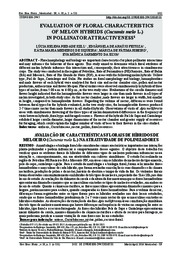Evaluation of floral characteristics of melon hybrids (Cucumis melo l.) in pollinator attractiveness.
Evaluation of floral characteristics of melon hybrids (Cucumis melo l.) in pollinator attractiveness.
Author(s): KIILL, L. H. P.; FEITOZA, E. de A.; SIQUEIRA, K. M. M. de; RIBEIRO, M. de F.; SILVA, E. M. S. da
Summary: Floral morphology and biology are important characteristics for plant-pollinator interactions and may influence the behavior of these agents. This study aimed to determine which floral attributes of different melon hybrids influence this interaction and, consequently, their attractiveness in simultaneous crops. The study was conducted in the region of Petrolina, State of Pernambuco (PE)/Juazeiro, State of Bahia (BA) and Mossoró, State of Rio Grande do Norte (RN), in areas with the following melon hybrids: Yellow type, Piel de Sapo, Cantaloupe and Galia. For studies on floral morphology and biology, hermaphrodites and male flowers of each hybrid were analyzed for their size and nectar chamber size, pollen and nectar production, anthesis time and flower lifespan. Floral visitors were observed simultaneously in hybrids of three types of melon, from 5:00 a.m. to 6:00 p.m., in the two study sites. Evaluations of the corolla diameter and flower height indicated that the hermaphrodite flowers were larger in size than male flowers in all types of melon investigated, in both study sites. As for nectar chamber, male flowers are larger in width, but smaller in height, compared to hermaphrodite flowers. Regarding the volume of nectar, differences were found between floral types for the hybrids evaluated, in the two study sites; the hermaphrodite flowers produced 2-7 times more nectar than male flowers in all studied hybrids. Observations of visits of Apis mellifera to areas with simultaneous flowering of the three types of melon demonstrated differences in the frequency of visits between hybrids, floral type and foraged resource. Flowers of the hybrids Piel de Sapo and Cantaloupe exhibited larger corolla diameter, larger dimensions of the nectar chamber and greater supply of resources for foraging, which could explain the higher number of visits of bees to their flowers in the sites studied.
Publication year: 2016
Types of publication: Journal article
Unit: Embrapa Semi-arid Region
Keywords: Anthesis, Biologia floral, Cucurbitaceae, Floral resources, Melão, Néctar, Polinização, Pólen, Recurso floral
Observation
Some of Embrapa's publications are published as ePub files. To read them, use or download one of the following free software options to your computer or mobile device. Android: Google Play Books; IOS: iBooks; Windows and Linux: Calibre.
Access other publications
Access the Agricultural Research Database (BDPA) to consult Embrapa's full library collection and records.
Visit Embrapa Bookstore to purchase books and other publications sold by Embrapa.

